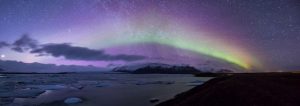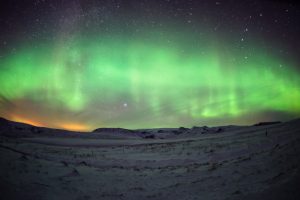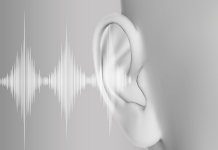Aurora borealis, also known as Northern lights, are an eternal display of gleaming lights across the sky. What causes Aurora Borealis? Some of the ancient cultures believed that these were the spirits rising while others thought it to be an omen of their victory at war.

Back in 1616, the astronomer Galileo Galilei named the phenomenal lights as Aurora Borealis, naming them after the Roman goddess of the dawn and wind of the North, respectively. But the best theory that came forward was proposed by Kristian Birkeland in 1903, a Norwegian scientist.
Scientifically, it is caused by a rush of charged particles from the Sun which interact with Earth’s magnetic field to produce the shimmering lights. The Earth’s magnetic field is known as Magnetosphere. The Magnetosphere is supposed to prevent these particles from entering the Earth. While some of these particles get diverted along magnetic field of Earth to poles. From poles, they enter in the Earth’s atmosphere. Where these particles interact with gases such as nitrogen (N2) and oxygen (O2) causing them to radiate light.
The aurora produced in the Northern hemisphere of Earth is known as aurora borealis. The Aurora Australis is the spray of these bands in the Southern Hemisphere which lights up the Antarctic skies.
The colors produced depends on three factors:
- Types of gases
- The altitude of these gases
- The temperature of the atmosphere
The Aurora appears as arcs, spirals, the curtain of lights, etc. depending upon the direction of forces of the magnetic field. These are usually green in color, sometimes a hue of pink, red, white and violet colors. They may appear static or when the flare is strong as the dancing spirit of lights.
Where these lights are usually seen?

In the far North, countries across the borders of the Arctic Ocean such as Canada, Iceland, Greenland, Russia. The strong blend of colors can be seen at southern latitudes in the United States. This is because different gases give different colors. For example, oxygen emits a green color of the Aurora, Nitrogen blue or red colors. This band of light disperses according to the altitude such as:
- Blue up to 60 miles (96.5 km) of altitude
- Purple and violet above 60 miles
- The green light at an altitude of 150 miles (241 km)
- Red above 150 miles
What is the best time to get lost in aurora borealis?
Winter is the best season to observe these lights due to clear air and least light pollution. September, October, March, and April being the best months for the display. In fact, NASA and other agencies wait for these months when they are to put on some air show.
People travel thousands of miles across the borders to spell-bound by these magical, shimmering nights. The display is scenic and still gives an image of dancing ghosts out there.
Some Interesting Facts:
-
- The most significant night display occurs almost after 11 years.
- Since 1749, 22 full such cycles have been observed so far.
- Jupiter, Saturn, Neptune, and Uranus also experience these impressive displays.




















